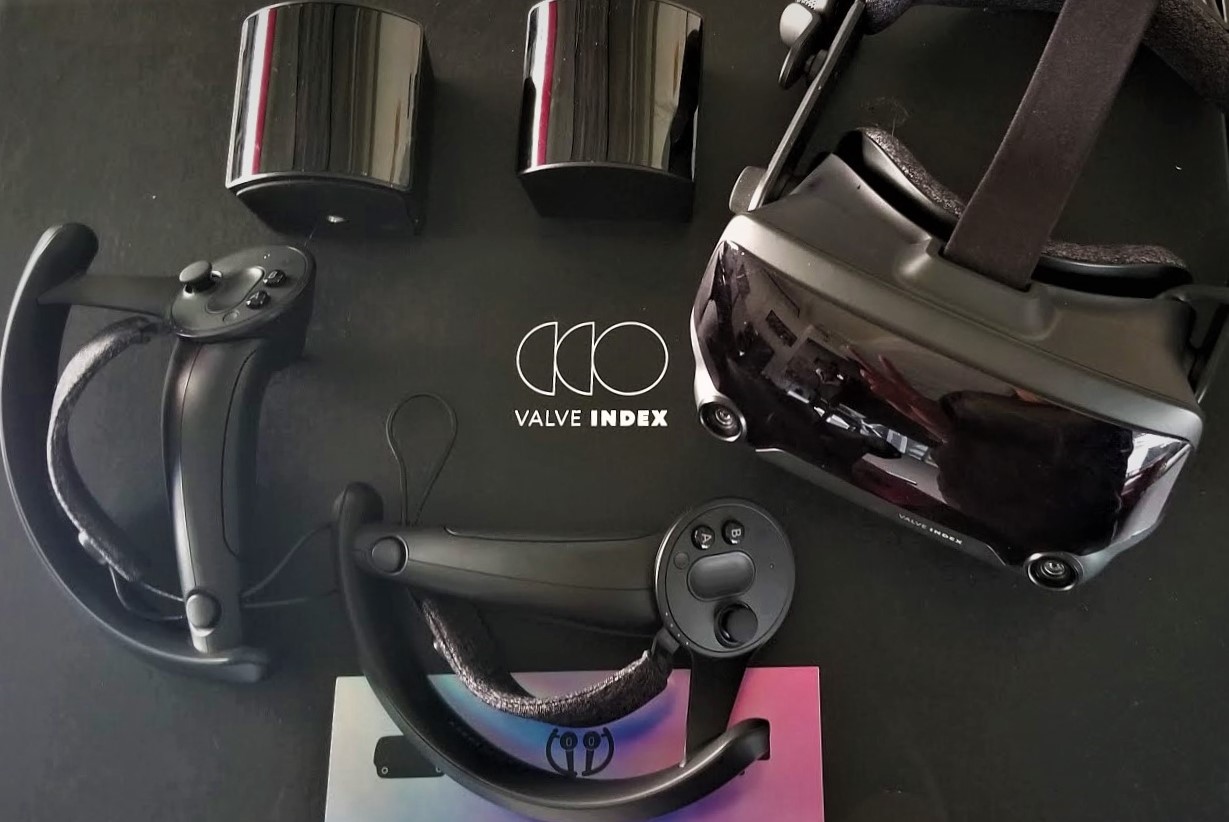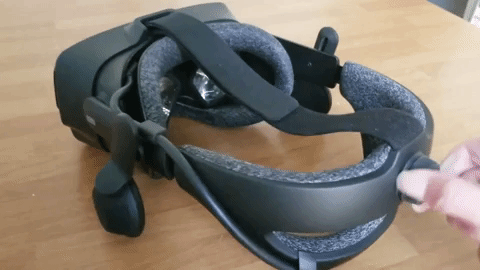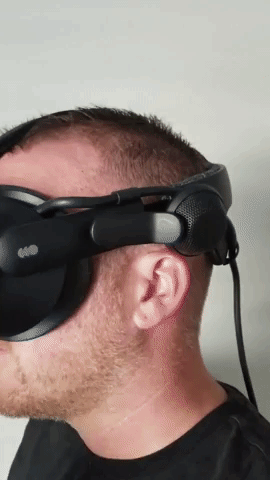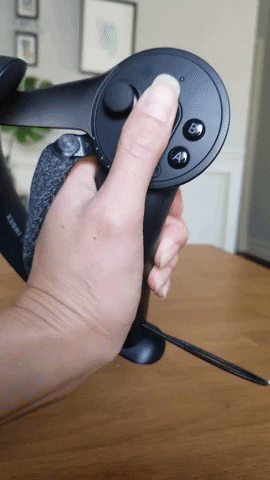
23 Sep Valve Index Review
The Valve Index is a virtual reality headset created and manufactured by Valve for VR-ready PCs and laptops. The entire kit, minus the PC, was released in June 2019 for $999. It has since been sold-out, backlogged with orders, and released again with more models after the March 2020 release of Half-Life: Alyx, a highly anticipated first-shooter only available to Valve owners for free. It was around the same time that we, at Futurus, got our hands on the Index. While several of us have gotten the chance to experience the headset and the game, Half-Life: Alyx is less my kind of speed. So if you’re looking for a review of the Valve Index itself, you’ve come to the right place.
Set-Up
If you have experience setting up HTC Vive or Oculus Rift, the process for the Index is very similar, especially if you are using SteamVR as your gaming library for setting up room-scale. Remember, Steam is hardware agnostic, meaning all the content you bring into the platform from playing on Oculus or HTC will work on the Valve Index and vice versa. Steam is also a great resource for step-by-step instructions on getting the Index connected and running. Overall, the physical set-up is straightforward and will get you ready to go virtual in minutes, depending on how in-depth you go with tracing cables around your room and moving furniture.
The set-up I’m testing with consists of:
- VR headset and cables, with headphones and adjustable straps
- Pair of controllers, lanyards, and charging cables
- Pair of 2.0 base stations and their power cables
- Pair of adjustable base station stands and mounting hardware
- PC connection and power cables
- A vinyl and foam face pad
Headset Fit and Comfort
When you are investing a considerable amount of dough for a high-powered VR console such as the Index, I would expect the fit and comfort of the head unit to be one of the designer’s primary concerns. In this department, the Index delivers. Personally, I have always preferred the design of headsets that are wired to PCs than standalone models like the newest Oculus, which, regardless, has been my main hardware for gaming since the Quest’s release. Before that, I was a regular user of the HTC Vive Pro, another superior unit in headset design and comfort. The one thing that is missing from the Index headset is volume controls.

What makes the Index’s design comfortable is the strap placement, the soft, antimicrobial materials and ergonomic padding, and the tightening knob in the back. There is no dependence on stretchy straps or Velcro to tighten the headset around your face, which causes me greater fatigue and unsightly but temporary red marks across my cheeks. The Index’s straps are expanded loosely by the knob, making it easy to put on and off without force, and then tightens by the knob around the crown of your head. This allows for someone with sensitivities to pressure around the head, like me, to play for more extended periods of time and without ongoing discomfort. The headset’s visor piece is adjustable and seemingly rests in place over your face without the need to be supported by your cheeks as well.
Headset Features
The adjustable speakers allow for a more natural experience that melds the virtual world with your physical by opting for an open-ear design. By not enclosing the audio within headphones, the audio sounds like part of your environment, which helps you be more aware of your physical surroundings, so you are not startled when someone is asking for your attention. With more space around your ears, air can flow more freely, which helps to keep you cool in the most intense gameplay sessions.

My eyes can play tricks on me, so I tend not to believe or even notice differences in vividness and sharpness of the Index’s duel 1440×1600 RGB LCDs compared to the Vive Pro or even the Quest, so I’ll take that claim at face value. However, Valve turns up the knob for visual quality by explaining how – physically placing the duel-element lenses as close to the eyes as possible. This whole package of improved pixel layout and lens positioning maximizes the user’s field of view and edge-to-edge clarity, thus eliminating blurry images and distorted shapes when you scan your eyes across the screen (instead of your head) and the oh-so-dreaded “screen-door” effect. Fine-tune your visual experience even more with physical adjustments of the distance between your eyes, known as IPD, and the distance from lens to eyes, known as eye relief. The knob to adjust IPD is found on the right side of the headset, and the slider to adjust eye relief is located under the visor to the right.
Controllers Fit and Comfort
The controllers are the shining piece of hardware for the entire Index kit. It is obvious how much thoughtful design and function went into the final iteration of what could be the most intuitive controllers in the VR realm right now, which makes sense given how much their prototype/previous model, the Knuckles, received similar acclaim. My favorite feature is the secure straps that wrap around your palm, allowing for gripless play and less fatigue. The bungee cord is pulled tight over the part of your hand that is already in contact with the controller, instead of relying on wrist lanyards to prevent accidental throws. To release, a push of a button loosens the cord from your hand, giving the user as much efficiency as possible without cumbersome help with the other hand. The straps are comfortable and are made of the same soft fabric as the headset.

Controller Features
Do you ever get an itch on your face in the middle of playing, and when you reach to scratch the spot while holding Vive or Oculus controllers, the top, circular part of the controller hits you in the face before your finger even touches you? Happens to me EVERY…TIME. The design of the Index controllers makes this a nonissue, with the motion sensors placed on the back of your hand, leaving you easy access to your fingers for your scratching pleasure without the disrupting loss of immersion.

While it does not look like there are many buttons to work with, the magic of the Index controllers is in the 87 complex sensors that are within reach of your palm, thumb, and fingers, giving you the most intuitive, naturally responsive, and sensitive pair of VR controllers on the market. These sensors, along with fine-tuned algorithms, can detect not only your fingers and the intent to push buttons but also motion – like the gesture of tapping your fingers – and force – from a light touch to a tight squeeze. What you do not see is that the main body of the grip IS the grip “button”! Securely let go of an object in VR just like in real life by opening your entire hand and control the force in your hand by closing your grip softly or tightly. The oval trackpad acts as a scroll wheel with a glide of your finger. The thumbstick allows for a similar action for games that do not integrate the trackpad yet. There definitely is no substitute for the Index trigger button. One thing I did find difficult was the inconvenient reach to the Home Button, below Button A and B, and because it is level with the face of the plate, pressing it can take extra effort. Trying to pause a fast-paced, nonstop game of Beat Saber causes me to miss hitting blocks or even fail the level if I struggle for too long. An extra nice touch is the ability to see each controller’s battery life directly on the virtual ones. With all these thoughtful features, Valve designers complemented the standard gaming triggers and buttons with smart sensors, haptics, and developer customizations so that the Index controllers are available for the growing library of content out there for anyone looking to upgrade their gameplay.
If you are a VR gamer or enthusiast, or even a total beginner looking for a complete kit with maximum power from a VR-ready PC, you cannot go wrong with a Valve Index. Its level of comfort, intuitive design, and function of all hardware pieces are far outdone by the minor inconveniences. Play smarter, longer, and more naturally, with access to many gaming titles that support the Index. Though the $999 price tag is not for the casual player, if you are looking for the best kit out there at the moment, this is worth the hype, as Half-Life: Alyx has proven.




